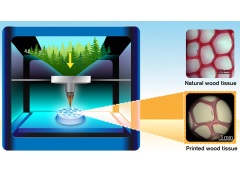Features
Printing wood
Date: 2019-07-10 09:11:44.0
Author: Jon Evans

The novel 3D printing process developed by
researchers at Chalmers University of
Technology can replicate the microstructure
of natural wood.
Image: Yen Strandqvist/Chalmers University of
Technology.
Wood is generally considered to be a versatile material, able to produce everything from paper to furniture to houses, but it’s not actually as versatile as first appears. To take advantage of wood’s toughness and strength, it can only be sawn or nailed. If it is chemically processed in any way, such as to produce paper, then it tends to lose its toughness and strength.
This reliance on sawing and nailing has always restricted the complexity of the objects that can be produced from unprocessed wood. But now, Paul Gatenholm and his colleagues at Chalmers University of Technology in Sweden have developed a 3D printing process that can make much more complex objects from wood while retaining its toughness and strength. Their process does this by closely replicating both the composition and microscopic structure of natural wood.
As with all plant biomass, wood is made of cellulose, hemicellulose and lignin. But mature wood consists of dead cells that have lost their internal cytoplasm, meaning they comprise a strong, thick cell wall of cellulose nanofibrils at different orientations, bound together by hemicellulose and lignin, surrounding a cavity. It is this structure that allows wood to be strong, tough and lightweight.
Researchers have already shown that dispersing wood-derived cellulose nanofibrils in water produces a hydrogel that can be used for 3D printing, in which objects are built up by depositing a material layer-by-layer in a defined pattern. But because they’re made solely of cellulose, the resultant objects don’t possess the strength and toughness of wood, collapsing if subjected to an external force. Gatenholm and his colleagues set out to change that.
One way they tried to do this was by adding hemicellulose to the cellulose nanofibril hydrogel. In actual fact, they added hemicellulose modified with tyramine, which performs the function of lignin, to help bind the cellulose nanofibers together. The other way they tried to do this was by printing the cellulose nanofibers at different orientations to replicate the honeycomb microstructure of wood, with thick walls surrounding a hollow cavity. This involved printing the objects on a stage that as well as moving vertically and horizontally could also be rotated.
Doing this with the cellulose nanofibril hydrogel on its own confirmed that the strength of the printed material changed depending on the orientation of the nanofibrils. The tensile strength of a printed, rectangular sheet was twice as high when the nanofibrils were oriented along the length of the sheet than when they were oriented across the width of the sheet. When Gatenholm and his colleagues used this approach to print an object that replicated the cellular structure of normal wood, albeit at a larger scale, they found the object was tough enough to withstand being compressed to 70% its normal height, before rebounding back.
As reported in a paper in Applied Materials Today, they next tried printing objects using a combination of the basic cellulose nanofibril hydrogel and the version that contained hemicellulose modified with tyramine, which revealed that the modified version swelled more when exposed to water. When combined with printing the nanofibrils at different orientations, Gatenholm and his colleagues found they could take advantage of this to print objects that changed shape on exposure to water.
“This is a breakthrough in manufacturing technology,” says Gatenholm. “It allows us to move beyond the limits of nature, to create new sustainable, green products. It means that those products which today are already forest-based can now be 3D printed, in a much shorter time. And the metals and plastics currently used in 3D printing can be replaced with a renewable, sustainable alternative.”
Lignin, the other main component of wood, isn’t being left out though. Last year, researchers from Oak Ridge National Laboratory in Tennessee, US, showed that lignin could also be used for 3D printing, by combining it with acrylonitrile-butadiene-styrene (ABS) and acrylonitrile-butadiene rubber (see Natural Approach to 3D printing). Since then, in a paper in Science Advances, the researchers reported that an even better material for 3D printing can be produced by simply combining lignin with nylon, especially if they add carbon fibers as well. This all suggests that wood could soon become a lot more versatile than it first appears.
The views represented here are solely those of the author and do not necessarily represent those of John Wiley and Sons, Ltd. or of the SCI.
Displaying 2 keywords used to tag this article:
- Jules Audemars-Australia Best Quali
- DG6582 Mens Moncler Down Jackets Gr
